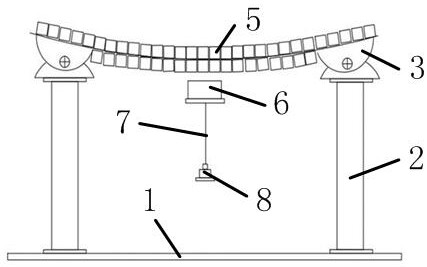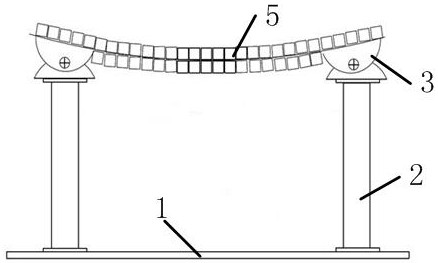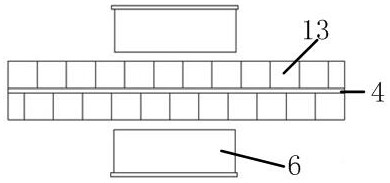A multifunctional magnetic levitation pendulum experimental device
An experimental device and magnetic levitation technology, applied in teaching models, instruments, educational appliances, etc., can solve the problems of single experimental phenomenon, single function, small scope of application, etc., and achieve the effect of simple operation, easy portability and wide application scope.
- Summary
- Abstract
- Description
- Claims
- Application Information
AI Technical Summary
Problems solved by technology
Method used
Image
Examples
Embodiment 1
[0037] In order to solve the technical problem that the physical experiment device in the prior art has a small application range and increases the teaching cost, this embodiment provides a multifunctional magnetic levitation pendulum experimental device, such as figure 1 , figure 2 , image 3 , Figure 4 As shown, the bottom plate 1 is included, and the top surface of the bottom plate 1 is vertically fixed with two brackets 2, and the top of the bracket 2 is hinged with a mounting part 3; a magnet attachment plate 4 is arranged between the two brackets 2, and the two ends of the magnet attachment plate 4 They are respectively fixedly connected with the installation part 3; the top and bottom surfaces of the magnet attachment plate 4 are provided with magnet tracks 5; the magnetic levitation track above or below the magnet attachment plate 4 is provided with a superconducting block 6 (the superconducting block is placed in a plastic box inside); the superconducting block 6 ...
Embodiment 2
[0045] On the basis of embodiment 1, the experimental assembly of this embodiment is a cycloid 7, such as figure 1 As shown, a thin wire is used as the cycloid 7, and the pendulum 8 and the superconductor are connected with the thin wire. When the superconductor enters the superconducting state, it will be suspended under the magnet track 5, and the length of the cycloid 7 is measured. When the pendulum is released by external force After the hammer 8, it is seen that the pendulum 8 performs a conical pendulum motion, and at the same time drives the superconducting block 6 to run along the track under the magnet track 5. When the pendulum 8 passes through the equilibrium position, the period is obtained at last, and it is found that the calculated period is too small, which proves that the pendulum 8 performs conical pendulum motion. That is to say, the period of the simple pendulum is too small when it moves as a conical pendulum.
Embodiment 3
[0047] On the basis of the foregoing embodiments, the cycloid 7 is replaced with a light rod 9, as Figure 5 As shown, a light rod 9 is used to connect the pendulum 8 and the superconducting block 6. After the superconductor is cooled with liquid nitrogen and enters the superconducting state, it will be suspended under the magnet track 5. The pendulum length is measured. When the pendulum 8 is pushed by an external force, the pendulum The hammer 8 and the light rod 9 move together, no obvious conical pendulum phenomenon is observed, and the measured period is relatively small. The reason for the analysis is that the light rod 9 has mass.
PUM
 Login to View More
Login to View More Abstract
Description
Claims
Application Information
 Login to View More
Login to View More - R&D
- Intellectual Property
- Life Sciences
- Materials
- Tech Scout
- Unparalleled Data Quality
- Higher Quality Content
- 60% Fewer Hallucinations
Browse by: Latest US Patents, China's latest patents, Technical Efficacy Thesaurus, Application Domain, Technology Topic, Popular Technical Reports.
© 2025 PatSnap. All rights reserved.Legal|Privacy policy|Modern Slavery Act Transparency Statement|Sitemap|About US| Contact US: help@patsnap.com



